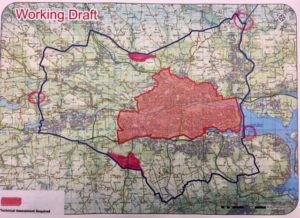“That in view of the risk balloons waste can pose to wild animals, birds and the marine environment and its contribution to litter generally, Cork County Council would ban balloon releases within its jurisdiction.”
“Balloon releases are beautiful. They are emotional, symbolic and are generally organised for very worthy charitable causes and special commemorative events.
But the reality is that the few minutes that magnificent visual impact is over, the balloons don’t disappear. Between 80 – 95% of released balloons rise to an altitude of 5 miles where the pressure and temperature is such that they burst into small fragments. The remaining 5 – 15% don’t make it that high and can float many miles before descending back to the land or sea, semi-inflated.
Balloons can be made of either mylar or latex. Mylar is a plastic and simply doesn’t biodegrade. Latex in the natural state is biodegradable but balloons on land can take 6 months to biodegrade and in salt water, 12 months. During this time, they are a particularly dangerous litter.
On land, balloon fragments can harm wild and domestic animals and livestock. In the marine environment, sea turtles, birds and other surface-feeding animals can mistake floating balloons for jellyfish and may attempt to eat them. Balloons can directly cause a slow and miserable death by blocking the digestive tract, eventually leading to starvation. This has been witnessed and documented by organisations all over the world including the UK DEFRA and latex balloons have been found in the digestive systems of many species in Irish waters, including some of which are protected by law. In sea turtles, balloons have in fact been found to reside without digestion or excretion for up to 4 months.
Balloons can cause death indirectly because more than 95% of phytoplankton, the essential building blocks of marine ecosystems, are killed by latex rubber within 4 days. Moreover, the word “biodegradable” does not identify that in degrading, latex goes through a sticky phase which increases the choking risk if it is ingested.
Birds legs and necks have become wrapped in the strings attached to balloons. When flippers and fins of sea turtles, seals and dolphins become similarly entrapped, it can cause infection, amputation and death by drowning.
All that aside, a staggering 8% of the world’s helium supply is used for filling party balloons. Helium is a non-renewable resource which we desperately need for other products we treasure such as MRI scanners, fibre optics and LCD screens.
The UK Marine Conservation Society has found a frightening average of 3 balloons per km of coast surveyed. Surveys of beach litter in the UK have found that the number of balloons and balloon fragments has tripled in the past 10 years, doubling between 2015 and 2016 alone.
Balloon releases have been banned in several states in the US including California, Connecticut, Florida, Tennessee and Virginia. At least 7 other US cities have similar laws in place. They have been banned in places in Australia. 34 local authorities in England, 10 in Scotland, 14 in Wales and 4 in Northern Ireland have forbidden balloon releases on public ground.
Environmental organisations all over the world have been asking for a ban on balloon releases for many years.
It is tragic that generally because of a lack of awareness, something that is beautiful, poignant and celebratory should cause so much downstream destruction, suffering and death. There are other equally wonderful ways in which events can be marked, ways which do not cause downstream environmental harm.
I welcome the sensitive and considered response from the executive.”


